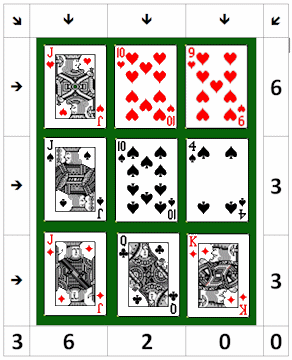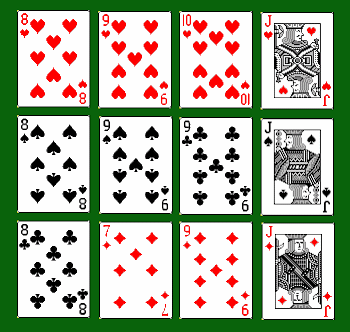Copyright
- Cards
- 52 (or, if more than four play, 104), ranking AKQJ1098765432 in each suit. Deal nine each, stack the rest face down as a stock, and turn its top card face up to start a discard pile.
- Object
-
To transform your hand of nine cards into one that will produce the highest-scoring grid of 3 x 3 cards,
scores being made for Brag combinations
in each of its eight lines (three rows, three columns and two diagonals). From highest to lowest, Brag combinations
and their scores in Brummy are:
- Prial (pair royal): three cards of the same rank, e.g. A-A-A. Scores 6
- Running flush: three cards in suit and sequence, e.g. A-2-3 of hearts. Scores 6
- Flush: three cards of the same suit, not all in sequence. Scores 3
- Run: three cards in sequence, not all of one suit. Scores 3
- Pair: two cards of the same rank plus a non-matching third card. Scores 2
Note 2: If you are using a double pack, two identical cards must not appear in the same row, column or diagonal, otherwise that line scores 0 regardless of any combination it may contain. - Play
- Starting with the player at dealer's left, you each in turn draw either the top card of the face-down stock or the top card of the face-up discard pile, add it to your hand, and reject any unwanted card face up to the discard pile. If you draw an unwanted card from the stock you may discard it immediately (at risk of giving away information), but if you draw the top discard you must replace it with a different one.
- Knocking
- If at any point you think you have the best hand you may "knock" by placing your discard transversely across the top of the discard pile. Each other player may then make one more draw and discard (but may pass if preferred). This ends the play. If no one knocks before the stock is empty, play ceases when the last card has been drawn from it. Each other player in turn may then, if desired, make one more exchange with the top card of the discard pile.
- Score
-
At end of play
 you each arrange your nine cards into a grid of 3 x 3, seeking to score as high
as possible. This example (right) scores a total of 23 as follows: (horizontally) 6
for the running flush, 3 for the spade flush, 3 for the run; (vertically)
6 for the Jacks, 2 for the pair of 10s, 0 for the third column;
top left diagonal = 0, top right diagonal = 3 for the run.
Note that runs needn't be laid out in strict sequence. For example, 9-J-10 is as good as 9-10-J.
you each arrange your nine cards into a grid of 3 x 3, seeking to score as high
as possible. This example (right) scores a total of 23 as follows: (horizontally) 6
for the running flush, 3 for the spade flush, 3 for the run; (vertically)
6 for the Jacks, 2 for the pair of 10s, 0 for the third column;
top left diagonal = 0, top right diagonal = 3 for the run.
Note that runs needn't be laid out in strict sequence. For example, 9-J-10 is as good as 9-10-J. - Bonuses
- If you knock, you add a bonus of 10 points, but only if your grid produces the highest score. If it doesn't, a bonus of 5 points is awarded to each player who scores the same as you, and10 to anyone who scores higher. If a game ends without any knocking, no bonus is available.
- Game
- The turn to deal to the next round passes always to the left. Play up to any agreed target, such as 201 for a game lasting about ten deals.
- Optional scoring extra
- A line containing no combination higher than a pair scores 1 point for each unmatched face card it contains. For example, K-2-5 scores 1, K-3-Q scores 2, Q-Q-J scores 3 (2 for the pair plus 1 for the odd Jack). Applied to the illustration above, this yields an extra 1 point for the right-hand column and 2 for the top left diagonal, increasing the overall score to 26.
BRUMMAGEM
The enlarged (3x4) version of Brummy
This version is probably best for two. If three play, a doubled pack of 104 cards is preferable.
The basic rules of play are as described above, except that
(1) you are each dealt 12 cards instead of nine,
(2) you must eventually arrange them in a grid of 3x4 cards, and
(3) you score only for rows and columns, not diagonals (unless you want to make it ridiculously complicated).
The four-card rows require additional scores as follows:
The enlarged (3x4) version of Brummy
- Four-card run or flush scores 4
- Double pair royal (four of a kind) scores 12
- Four-card running flush scores 12
 a line of four cards scores for every distinct combination it contains.
a line of four cards scores for every distinct combination it contains.Here's an example: Top row = 12 (running flush)
Middle row = 5 (2 for the pair, 3 for the 3-card flush)
Bottom row = 6 (3 for the run, 3 for the flush)
Column 1 = 6
Column 2 = 2
Colum 3 = 2
Column 4 = 6
Total = 42 The highest possible score is 60 (three double pair royals and four running flushes, or three running flushes and four prials), plus 10 for knocking or beating the knocker.